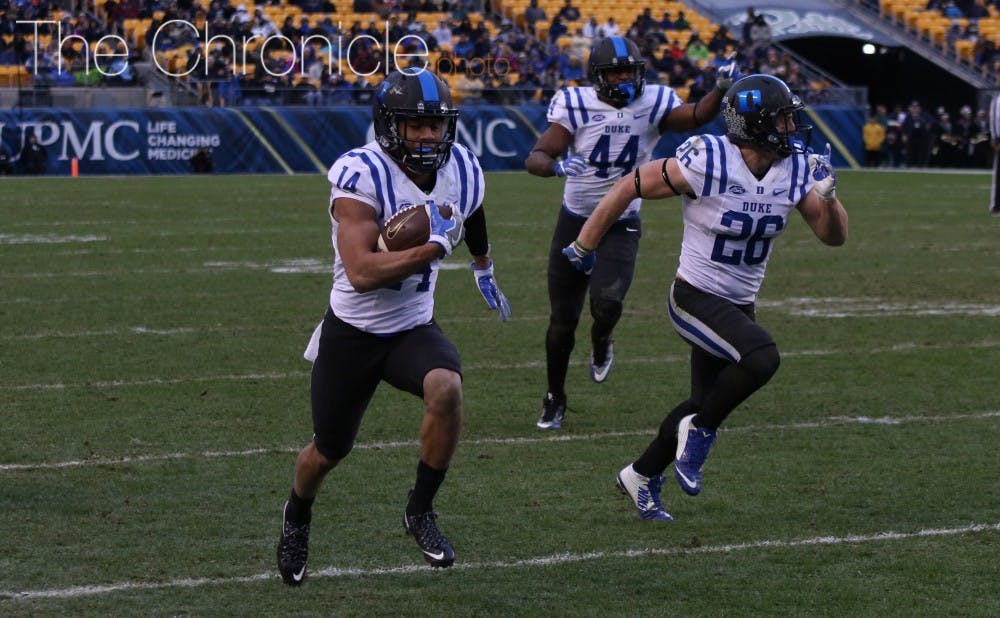Last season, Duke’s veteran secondary was torched in the passing game, finishing next to last in the ACC defensive pass efficiency. Despite losing four staples from their secondary, the Blue Devils expect to improve this season.
How? By simplifying the defense.
Often last season, opposing wide receivers ran free during communication breakdowns—a trend that became more frequent after veteran stars DeVon Edwards and Breon Borders went down with injuries, and inexperienced players had to work with starters that they might have only had limited practice time with.
“One thing that we’ve done with a lot of young guys on the defense is simplification, so just a couple calls, then guys really learn and understand and get a deep understanding of what we want to do with those few calls, and it’s letting guys play,” redshirt senior cornerback Bryon Fields said at ACC media day in July. “A lot of times, mistakes come from trying to do too much, overthinking. We’ve definitely limited that, and I think we’ll have some guys make a lot more plays and you’ll see a lot less explosives this year.”
Communication issues stood out especially in Duke’s final two contests last season, when it surrendered 56 and 40 points to Pittsburgh and Miami, respectively. With a potential bowl game on the line—needing just five wins to likely become bowl-eligible—the defense faltered, and the Blue Devils failed to reach the postseason for the first time since 2011.
The Blue Devil secondary frequently let receivers run free downfield for big gains numerous times, but both Cutcliffe and Fields reiterated during fall camp that “a confused football player looks like an unmotivated football player,” prompting them to change the way they make playcalls.
Count Fields as one who believes that the streamlined defense will reap benefits this season, especially for some of the younger players.
“We’ve got a lot of young guys who saw some playing time last year but are going to see a lot more this year,” Fields said. “Those guys have embraced their roles and really been working hard, kind of not forgetting about last season, but they’re really working toward this season.”
Since defensive coordinator Jim Knowles arrived in Durham before the 2010 season, he has employed a 4-2-5 defensive scheme, benefitting from standout talents in the secondary, including All-American Jeremy Cash and current Pittsburgh Steelers cornerback Ross Cockrell. Despite enjoying a wealth of production from a deep linebacking corps heading into this season, Knowles is standing firm using his trademark formation, relying on the simplification to obtain better results in the five-man secondary.
Although Fields is the only returning starter, the Blue Devils have a plethora of defensive backs who saw time on the field last season, but a few might be in different positions.
Despite undergoing thumb surgery nearly two weeks ago, strike safety Jeremy McDuffie made an impression on the coaching staff after playing cornerback the last two seasons. He is expected to play in a cast to start the season.
If healthy, McDuffie should slide into Cash’s, and more recently Corbin McCarthy’s role, a position the coaching staff expects him to thrive in due to his speed and athleticism—McDuffie was an All-ACC performer in both the triple jump and hurdles in track and field in the spring.
Brandon Feamster, who is attempting the opposite transition from safety to cornerback, has also drawn strong reviews this offseason.
“One of the keys right now to our defense—and I hope he can stay healthy—is I think Jeremy McDuffie has found a home at our strike [safety position],” head coach David Cutcliffe said in July before McDuffie’s thumb injury. “His ability to do so many things gives us some flexibility that we haven’t had before.”
After back-to-back strong recruiting classes boasting four-star defensive back recruits, Duke hopes to start to see some of the benefits. Sophomore and previous four-star recruit Dylan Singleton, who impressed on special teams last season, figures to split time with senior Alonzo Saxton II at the rover safety position, and redshirt sophomore Jordan Hayes is expected to occupy the bandit safety position, with true freshman Marquis Waters pushing for time as well.
The final piece of the secondary—the cornerback opposite Fields—will be sophomore Mark Gilbert, who shined in Borders’ place last season, especially in Duke’s 28-27 upset victory against North Carolina. At 6-foot-1, Gilbert had little issue matching up with taller wideouts and figures to do more of the same this season.
But along with young talent comes inexperience for this Blue Devil defensive backfield. Knowles, Cutcliffe and the rest of the Duke squad know they are taking a major risk relying on a talented but young secondary, especially after the issues that have plagued them in the past. Simplifying defensive signals and communication is not a surefire path to success, and it may be the reason why Cutcliffe’s squad either takes a step forward or remains stuck in the mud in 2017.
“That’s how explosives are made, through not communicating with each other,” Saxton said. “[We need to be] sure we’re all on the same page making the right reads and the right checks.”
Hank Tucker contributed reporting.
Get The Chronicle straight to your inbox
Signup for our weekly newsletter. Cancel at any time.

